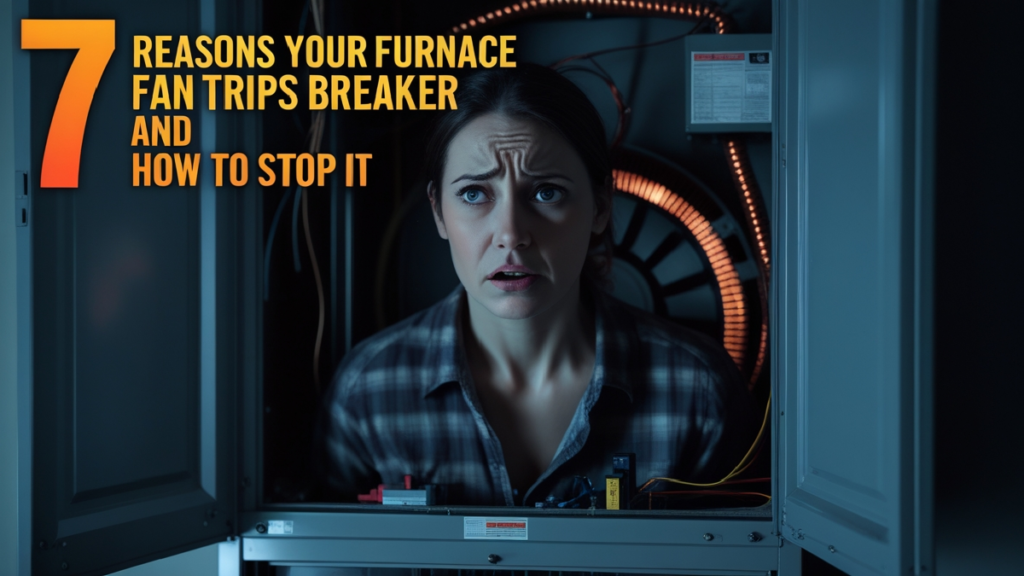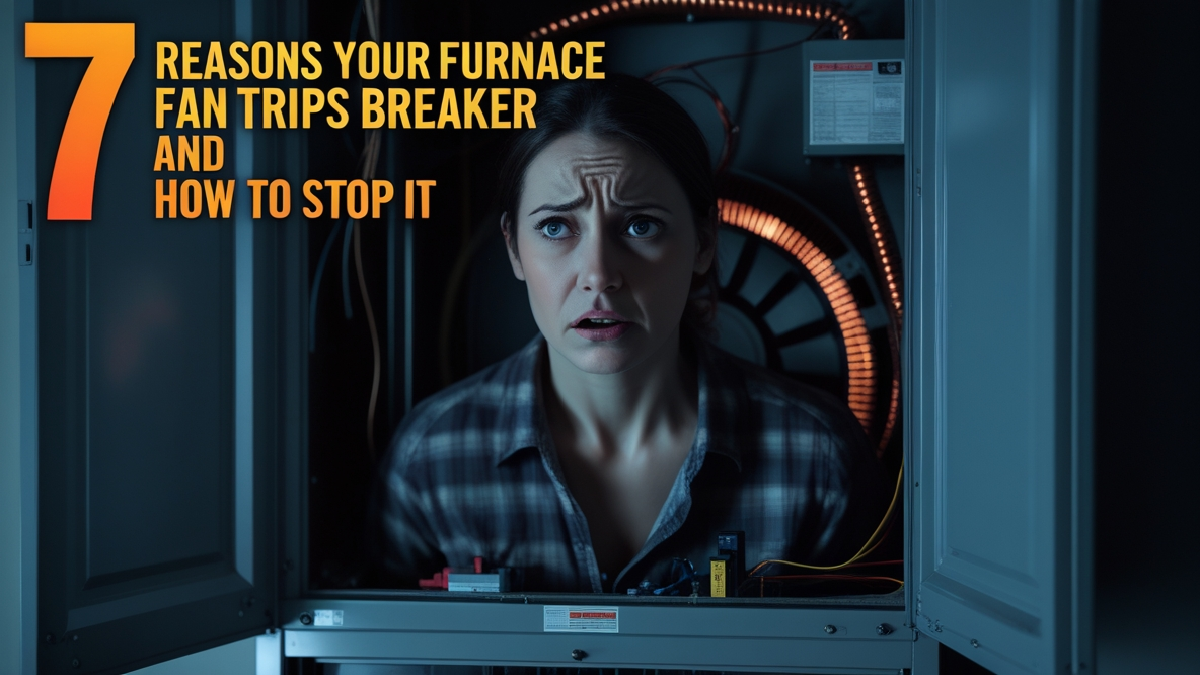Understanding the Issue: Why Your Furnace Fan Trips Breaker
Experiencing a furnace fan trips breaker situation can be both frustrating and concerning for homeowners. This problem not only interrupts the comfort provided by your heating system but also indicates potential safety hazards that need prompt attention.

The main reason behind a furnace fan trips breaker is usually due to an electrical overload or a short circuit within the fan motor or associated electrical components. When the fan draws more current than the circuit can safely handle, the breaker trips to prevent overheating, electrical fires, or damage to your system. Recognizing why this occurs is the first step toward addressing the problem effectively.
Several factors can contribute to this issue. Worn-out motor bearings can cause the fan to work harder, increasing electrical load. Faulty wiring, whether from age, damage, or poor installation, can lead to short circuits or intermittent connections.
Debris or dirt obstructing the fan blades can also cause the motor to strain, drawing excess current. Sometimes, the breaker itself may be faulty or unable to handle the current load, leading to frequent trips. Understanding these potential causes helps homeowners troubleshoot with confidence and ensures their heating systems operate safely and efficiently.
Common Causes of Furnace Fan Tripping Breaker
Identifying the root causes of a furnace fan trips breaker is essential for accurate diagnosis and effective repair. The most common reasons include electrical faults, mechanical failures, and system overloads.
Electrical Short Circuits
A short circuit happens when the wiring within the fan motor or control board develops a direct connection to the ground or another wire, causing a surge of current that trips the breaker. Damaged insulation, loose connections, or faulty wiring components are typical culprits.
Worn-Out or Faulty Fan Motor
Over time, the fan motor can wear down or develop internal faults. A failing motor often draws excessive current, which can trigger the breaker to trip. Signs of a faulty motor include unusual noises, a fan that fails to start, or inconsistent operation — all of which may lead to a furnace fan trips breaker problem.
Dirty or Obstructed Fan Blades
Accumulation of dirt, dust, or debris on the fan blades can cause the motor to work harder to turn the blades. This increased effort results in a higher electrical load, raising the risk of a breaker trip and leading again to a furnace fan trips breaker issue.
Electrical Wiring Issues
Loose, frayed, or damaged wiring connections can lead to intermittent power supply or short circuits, causing the furnace fan trips breaker unexpectedly.
Overloaded Circuit
Sharing a circuit with multiple appliances or systems can overload the circuit, especially if the furnace fan is drawing maximum power. This overload can cause the breaker to trip to prevent damage.
Faulty Breaker
Sometimes, the breaker itself may be defective or worn out, leading to false trips or failure to trip when needed, which can complicate troubleshooting efforts.
Step-by-Step Troubleshooting Guide for a Furnace Fan Trips Breaker
When your furnace fan trips breaker, it’s crucial to approach troubleshooting systematically. This ensures safety and helps accurately identify the problem. Here’s a comprehensive step-by-step guide:
- Turn Off Power and Disconnect the Furnace
Begin by turning off the main power supply to your furnace. Use a multimeter to verify that there is no voltage present before proceeding. This initial step is essential to prevent electrical shock and avoid causing further damage to your system. - Check the Circuit Breaker
Inspect the circuit breaker itself for signs of damage, such as burn marks, corrosion, or a tripped position. If the breaker frequently trips or appears faulty, consider replacing it or consulting a professional electrician. Reset the breaker carefully, but if it trips again immediately, further investigation is necessary. - Examine the Fan Motor and Wiring
Carefully inspect the wiring connected to the fan motor. Look for loose, frayed, or burnt wires that could cause a short circuit. Test the wiring using a multimeter. Replace or repair damaged wiring as needed to avoid another furnace fan trips breaker situation. - Test the Fan Motor
Disconnect the fan motor from its power source and perform a resistance test. Abnormal readings or no continuity indicate a faulty motor that may need replacement. Also, manually spin the fan blades to listen for unusual noises, which could suggest bearing issues or internal faults. - Clear Obstructions and Clean the Fan
Remove any debris, dust, or dirt from the fan blades and motor area. Ensure that the blades can rotate freely without resistance. Obstructions increase the load on the motor, raising the risk of another furnace fan trips breaker incident. - Test the System Under Controlled Conditions
After cleaning, restore power and turn on the furnace. Observe whether the fan operates smoothly without tripping the breaker. If it trips again, further testing or professional assistance may be required.
Safety Precautions and Maintenance Tips to Prevent Future Breaker Trips
Preventative maintenance and safety precautions are key to avoiding future furnace fan trips breaker issues. Regular upkeep can significantly reduce the likelihood of electrical problems.
- Always turn off power before inspecting or working on your furnace.
- Schedule annual professional HVAC inspections to keep components in optimal condition.
- Clean fan blades and motor areas annually to prevent strain on the motor.
- Inspect wiring connections for wear or damage and replace any frayed or loose wires immediately.
- Make sure your circuit breaker is rated appropriately for your furnace’s load.
If you experience frequent trips, consult an electrician to evaluate whether your electrical system needs an upgrade or additional dedicated circuits.
When to Call a Professional
While some troubleshooting steps can be safely performed by homeowners, certain issues require the expertise of a licensed HVAC technician or electrician.
If your furnace fan trips breaker despite all efforts, or if you notice electrical damage, burning smells, or sparks, professional help is essential. Handling electrical issues improperly can lead to serious hazards, so it’s always better to call an expert.
Conclusion
Addressing a furnace fan trips breaker issue requires a careful, systematic approach that emphasizes safety and technical accuracy. Common causes such as wiring faults, motor failure, debris, or overloaded circuits can often be diagnosed through basic troubleshooting.
However, persistent problems should always be handled by qualified professionals to ensure safety and system longevity. Regular maintenance, prompt repairs, and safety precautions will prevent future breaker trips and keep your home warm and secure.
If your furnace fan trips breaker frequently, don’t delay in taking action—timely diagnosis and repairs save time, money, and safety risks. Remember, a well-maintained furnace operates reliably without causing electrical issues like the furnace fan trips breaker.
Related Resource: For more Gas Furnace Venting Codes, visit our Facebook page.


Leave a Reply